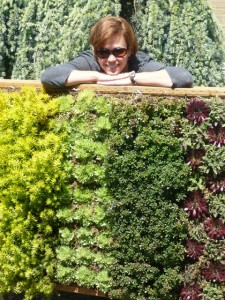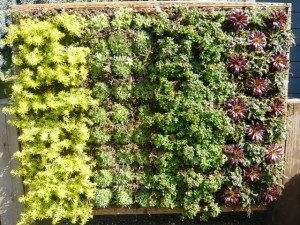Everyone wants a “green” planted wall
June 2nd, 2009

Carina Langstraat's delicious planted wall
Green walls are the hot, new, must-have landscape design element. The Europeans were the first to figure out how to engineer large-scale planted walls, inspiring some innovative American designers to follow with their own twist. From my research, most are here on the West Coast, natch.
My friend Flora Grubb in San Francisco has received quite a bit of press for her avant-garde planted wall tapestries that incorporate everything from succulents to air plants (Tillandsias).
And recently, the Los Angeles Times featured green wall designs using edibles (by Go Green Gardeners’ Anne Phillips) and California native plants + succulents embedded with LED lighting (by L.A. artist Michel Horvat).
HOW DID THIS TREND GET STARTED?
Garden writers have been describing “vertical elements” in the landscape for years. Traditionally, this idea involved arbors, trellises, fences and other structures upon which vines and climbing plants are trained. An explosion of interest in “green” planted roofs – including here in Los Angeles – followed. Pamela Berstler and Marliee Kuhlmann, two cool LA designers, create planted succulent “sky-scapes” for their clients’ garden roofs. I’ve seen, touched, and admired their work – and I can tell you, a lush, foliage-strewn roof is a lot more snazzy (and eco-smart) than tile, composite or tar!
But privately, some designers have confided to me their concern about liability issues involved in engineering green roofs. Even when I wrote on this topic for the Los Angeles Times in 2007, the experts I quoted cautioned that roof structures should be designed with load-bearing supports to manage soil/planting medium, handling moisture, and just the sheer weight of plants.
So, it’s only natural that the planted wall is the next installment of “plants-as-architecture” – a trend that seems more achievable than a green roof. I love seeing how designers are “going vertical” with a planted foliage palette.
THE WALL AS A PLANTING CANVAS
One of my favorite designers, Seattle-based Carina Langstraat (who runs Langstraat-Wood Landscape Architecture & Design with her landscape architect partner Erik Wood), has recently engineered a 4-foot by 5-foot green wall prototype at her Ballard studio. She shared with me photos and tips on how she created the system. It’s exciting to think about the possibilities, whether you’re willing to play around with this concept on your own or if you want to hire a professional.
Carina began investigating living wall designs after seeing some cool ideas at the Northwest Flower & Garden Show this past February. “They couldn’t have been prettier, but I was frustrated because they were only displays,” Carina told me when we spoke by phone last week. She actually saw some of the dismantled green panels after the flower show, returned to a wholesale nursery that supplied the plants. Those designs were far from sustainable, though. Some of the plants didn’t adapt well to the wall environment (think vertical, shallow planting space, limited nutrients and moisture — all the variables that make a wall design challenging).
Carina didn’t get far with online resources for green walls, so she experimented and devised her own system. There are vendors who create prefabricated wall systems for planting, but so far, Carina hasn’t been able to find one willing to supply other landscape designers. “It’s all very hush-hush,” she says. “It was a bummer because these companies weren’t willing to sell me un-planted panels.”

Four bands of hardy succulents form this gorgeous design
In the end, like any clever and determined artist, Carina decided “it’s not rocket science.” She started playing with materials and plants to see what works best in the Pacific Northwest’s Zone 8-9 environs.
Considering that Seattle has experienced a few tough winters, Carina wanted to work with frost-hardy plants. “I wanted a wall that had winter hardy, evergreen, drought tolerant plants; one that requires limited maintenance and will last indefinitely. It needed to be irrigated with city water using a self-cleaning drip tube,” she says. Treated grey water or roof water could be substituted for an even more sustainable solution.
Carina built her 4-by-5 foot “frame” using pressure-treated 2-by-4s (Ipe or clear cedar are also possibilities, she says). Bagged planting medium fills the “box,” which is then prepared for the botanical canvas of succulents and sedums. The “front” of the shallow box is covered with 4-inch metal grid, attached to the wood frame. The grid openings are large enough to plant into directly.
Carina created a vertically-striped planting design using gold, light green, dark green and bronze-burgundy plants. From left to right, she planted 12-14 inch wide bands of:
Sedum angelina (gold)
Sempervivum tectorum (the common green houseleek)
Sedum oreganum (dark green)
Sempervivum tectorum ‘purpureum’ planted in a “checker-board” pattern with green Leptinella squalida, a ground cover.
“I am pretty excited with this pattern,” she says. (Me too, Carina! – it’s really beautiful and I would love to hang this on one of my blank outdoor walls!).
The plants stay in place, thanks to a neat trick of tucking floral moss between them. “I built my wall six weeks ago and it already looks really established,” Carina says. A Netafin-tube drip system is hidden within the wall, making it essentially “self-watering.”
Even still, Carina’s design cost her around $800 to build. She snagged some discounted scrap steel from Grating Pacific, which helped lower her expenses. If she adapts the system beyond a prototype, Carina figures it will cost $90 to $130 per square foot.
“This is a great application, especially for a residential market,” she says. “You can make this weird piece of art to fit into any vertically-challenging space.”
Think about it – if you’re sick of watching your neighbor as he/she washes the dishes just beyond your kitchen sink, maybe a living wall is the solution. Maybe it can be planted on two sides and you can split the cost with said neighbor!
“I think it’s an excellent alternative to a fence or hedge and it’s a good sound buffer,” Carina concludes.









June 3rd, 2009 at 2:37 am
Very interesting article! Adding this to my (long) future project list!
Plant Lady
Plant Lady’s last blog post..Weekly Walk – June 2, 2009
June 11th, 2009 at 11:36 am
My Mom used to always say “you’re driving me up the wall” when we 3 kids would get rambunctious! Now gardening is driving everyone “up the wall” I just found this article online and thought you would enjoy it. Maybe we could meet in the middle and check out Portland together someday! http://www.oregonlive.com/hg/index.ssf/2009/06/urban_gardens_go_up_the_wall.html
Cheers,
Lorene
Lorene’s last blog post..Never enough “Thyme” in the garden…
February 2nd, 2010 at 8:58 pm
Thanks for the excellent insight, once again wonderful post. visit my website if you have a chance http://www.scrapgoldcoins.com kind regards
February 6th, 2010 at 2:54 pm
interesting that you think the green walls are more achievable than the green roof – in the UK most people who I have spoken to are more concerned about the green wall than the green roofs – I think that is because green roofs (and brown roofs) have been successful for some years in Europe and there are plenty of working examples to draw on
there are less examples of green walls and i think there is a general feeling they are unsustainable – but hopefully that will change with the Woolly Pocket product